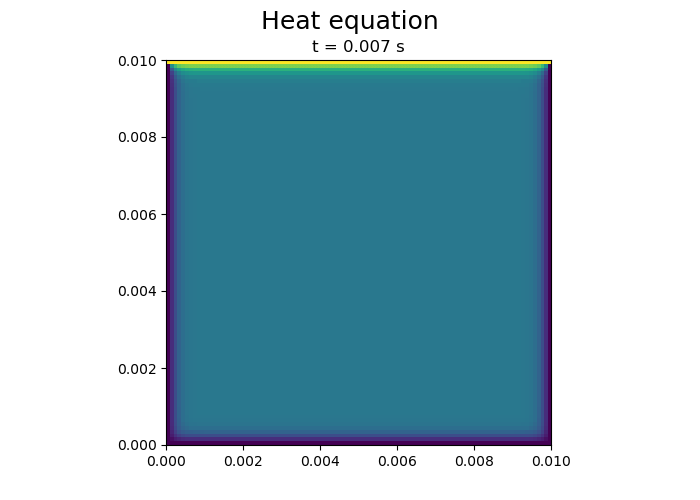Lecture Materials
Initial value problem: Heat equation#
In most cases we are studying the time evolution of a certain profile \(u(t,\mathbf{x})\). In this case PDEs describe the time evolution of the field(s) starting from some initial conditions and obeying boundary conditions.
Let us take the heat equation as an example. The field \(u\) is the temperature \(T\). In one dimension the heat equation reads
where \(D\) is the thermal diffusivity constant.
This equation describes the time evolution of \(u(t,x)\) given initial profile
and boundary conditions
If \(u_{\rm left}(t)\) and \(u_{\rm right}(t)\) are time-independent, we know that the solution will approach a stationary profile as \(t \to \infty\).
FTCS scheme#
FTCS (Finite Time Centered Space) scheme is the simplest method for solving the heat equation
First we discretize the spatial coordinate into a grid with \(N + 1\) points, i.e.
and approximate the derivative \(\partial^2 u / \partial x^2\) by the lowest order central difference
To evaluate the time evolution we will work with small time steps of size \(h\). The time derivative is approximated by the forward difference
This gives the following discretized equation
The method is explicit: to evaluate \(u(t+h,x)\) at the next time step we only need to know \(u(t,x)\) profile at the present time step. Denoting the discretized time variable by superscript \(n\) (such that \(t_n = hn\)) and the spatial variable by subscript \(k\) (such that \(x_k = ak\)) we get the following iterative procedure
Here
is a dimensionless parameter.
Implementation of the FTCS scheme#
Let us implement the FTCS scheme in Python
import numpy as np
# Single iteration of the FTCS scheme in the time direction
# r = Dh/a^2 is the dimensionless parameter
def heat_FTCS_iteration(u, r):
N = len(u) - 1
unew = np.empty_like(u)
# Boundary conditions
unew[0] = u[0]
unew[N] = u[N]
# FTCS scheme
for i in range(1,N):
unew[i] = u[i] + r * (u[i+1] - 2 * u[i] + u[i-1])
return unew
# Perform nsteps FTCS time iterations for the heat equation
# u0: the initial profile
# h: the size of the time step
# nsteps: number of time steps
# a: the spatial cell size
# D: the diffusion constant
def heat_FTCS_solve(u0, h, nsteps, a, D = 1.):
u = u0.copy()
r = h * D / a**2
for i in range(nsteps):
u = heat_FTCS_iteration(u, r)
return u
Example#
Let us consider the following problem: Example 9.3 from M. Newman, Computational Physics:
We have a 1 cm long steel container, initially at a temperature 20° C. It is placed in bath of cold water at 0° C and filled on top with hot water at 50° C. Our goal is to calculate the temperature profile as function of time. The thermal diffusivity constant for stainless steel is \(D = 4.25 \cdot 10^{-6}\) m\(^2\) s\(^{-1}\).
We will calculate the profile at times \(t = 0.01\) s, \(0.1\) s, \(0.4\) s, \(1\) s, and \(10\) s.
%%time
# Constants
L = 0.01 # Thickness of steel in meters
D = 4.25e-6 # Thermal diffusivity
N = 100 # Number of divisions in grid
a = L/N # Grid spacing
h = 1e-4 # Time-step (in s)
print("Solving the heat equation with FTCS scheme")
print("r = h*D/a^2 =",h*D/a**2)
Tlo = 0.0 # Low temperature in Celsius
Tmid = 20.0 # Intermediate temperature in Celsius
Thi = 50.0 # High temperature in Celsius
# Initialize
u = np.zeros([N+1],float)
# Initial temperature
u[1:N] = Tmid
# Boundary conditions
u[0] = Thi
u[N] = Tlo
# For the output
times = [ 0.01, 0.1, 0.4, 1.0, 10.0 ]
profiles = []
xk = [k*a for k in range(0,N+1)]
current_time = 0.
for time in times:
nsteps = round((time - current_time)/h)
u = heat_FTCS_solve(u, h, nsteps, a, D)
profiles.append(u.copy())
current_time = time
# Plot the results
import matplotlib.pyplot as plt
plt.title("Heat equation")
plt.xlabel('${x}$ [cm]')
plt.ylabel('${T}$ [Celsius]')
for i in range(len(times)):
plt.plot(xk,profiles[i],label="${t=}$" + str(times[i]) + " s")
plt.legend()
plt.show()
Solving the heat equation with FTCS scheme
r = h*D/a^2 = 0.0425
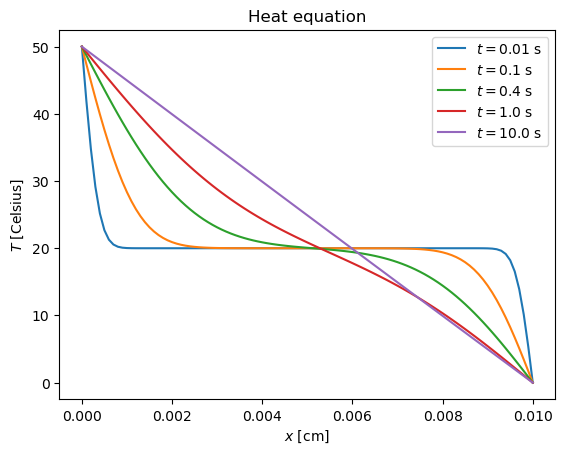
CPU times: user 4.37 s, sys: 1.88 s, total: 6.26 s
Wall time: 3.9 s
Convergence and stability#
Try a larger time step such that \(r > 1/2\)
%%time
# Constants
L = 0.01 # Thickness of steel in meters
D = 4.25e-6 # Thermal diffusivity
N = 100 # Number of divisions in grid
a = L/N # Grid spacing
h = 1.2e-3 # Time-step (in s)
print("Solving the heat equation with FTCS scheme")
print("r = h*D/a^2 =",h*D/a**2)
Tlo = 0.0 # Low temperature in Celsius
Tmid = 20.0 # Intermediate temperature in Celsius
Thi = 50.0 # High temperature in Celsius
# Initialize
u = np.zeros([N+1],float)
# Initial temperature
u[1:N] = Tmid
# Boundary conditions
u[0] = Thi
u[N] = Tlo
# For the output
times = [ 0.01, 0.1, 0.4, 1.0, 10.0 ]
profiles = []
xk = [k*a for k in range(0,N+1)]
current_time = 0.
for time in times:
nsteps = round((time - current_time)/h)
u = heat_FTCS_solve(u, h, nsteps, a, D)
profiles.append(u.copy())
current_time = time
plt.title("Heat equation")
plt.xlabel('${x}$ [cm]')
plt.ylabel('${T}$ [Celsius]')
for i in range(len(times)):
plt.plot(xk,profiles[i],label="${t=}$" + str(times[i]) + " s")
plt.legend()
plt.show()
Solving the heat equation with FTCS scheme
r = h*D/a^2 = 0.5099999999999999
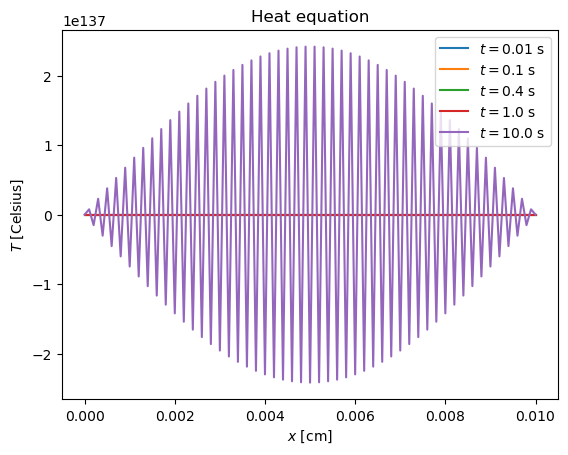
CPU times: user 849 ms, sys: 4.21 ms, total: 853 ms
Wall time: 392 ms
The method has become unstable. What if we increase the spatial size step to bring \(r\) back below 1/2?
%%time
# Constants
L = 0.01 # Thickness of steel in meters
D = 4.25e-6 # Thermal diffusivity
N = 90 # Number of divisions in grid
a = L/N # Grid spacing
h = 1.2e-3 # Time-step (in s)
print("Solving the heat equation with FTCS scheme")
print("r = h*D/a^2 =",h*D/a**2)
Tlo = 0.0 # Low temperature in Celsius
Tmid = 20.0 # Intermediate temperature in Celsius
Thi = 50.0 # High temperature in Celsius
# Initialize
u = np.zeros([N+1],float)
# Initial temperature
u[1:N] = Tmid
# Boundary conditions
u[0] = Thi
u[N] = Tlo
# For the output
times = [ 0.01, 0.1, 0.4, 1.0, 10.0 ]
profiles = []
xk = [k*a for k in range(0,N+1)]
current_time = 0.
for time in times:
nsteps = round((time - current_time)/h)
u = heat_FTCS_solve(u, h, nsteps, a, D)
profiles.append(u.copy())
current_time = time
plt.title("Heat equation")
plt.xlabel('${x}$ [cm]')
plt.ylabel('${T}$ [Celsius]')
for i in range(len(times)):
plt.plot(xk,profiles[i],label="${t=}$" + str(times[i]) + " s")
plt.legend()
plt.show()
Solving the heat equation with FTCS scheme
r = h*D/a^2 = 0.41309999999999986
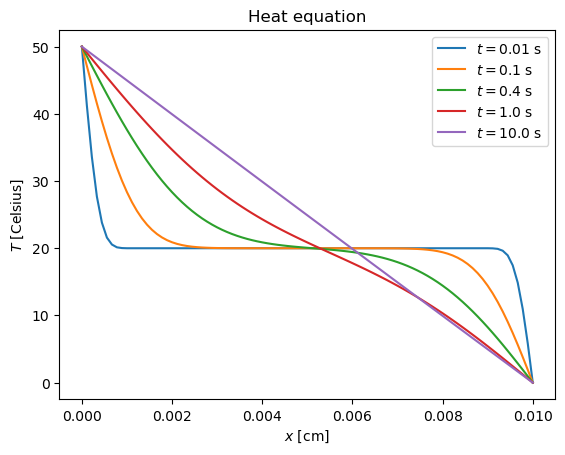
CPU times: user 805 ms, sys: 3.28 ms, total: 808 ms
Wall time: 341 ms
For \(r < 1/2\) the method is stable again.
This underlines the importance of the stability condition for explicit methods. Depending on the relation between time and space steps, we can either have a stable or unstable method. For heat equation the stability condition is
Implicit scheme#
In the implicit scheme one uses backward difference for the time derivative. This implies
thus
In discretized notation
In other words, we have a system of linear equations for \(u^{n+1}_i\):
The system should be solved at each time step. Luckily, the system is tridiagonal, so it is solved in linear time.
Implementation#
import numpy as np
# Single iteration of the implicit scheme in the time direction
# The new field is written into unew
# r = Dh/a^2 is the dimensionless parameter
def heat_implicit_iteration(u, r):
N = len(u) - 1
unew = np.empty_like(u)
# Boundary conditions
unew[0] = u[0]
unew[N] = u[N]
d = np.full(N-1, 1+2.*r)
ud = np.full(N-1, -r)
ld = np.full(N-1, -r)
v = np.array(u[1:N])
v[0] += r * u[0]
v[N-2] += r * u[N]
unew[1:N] = linsolve_tridiagonal(d,ld,ud,v)
return unew
# Perform nsteps implicit time iterations for the heat equation
# u0: the initial profile
# h: the size of the time step
# nsteps: number of time steps
# a: the spatial cell size
# D: the diffusion constant
def heat_implicit_solve(u0, h, nsteps, a, D = 1.):
u = u0.copy()
r = h * D / a**2
# print("Heat equation with r =", r)
for i in range(nsteps):
u = heat_implicit_iteration(u, r)
return u
%%time
# Constants
L = 0.01 # Thickness of steel in meters
D = 4.25e-6 # Thermal diffusivity
N = 100 # Number of divisions in grid
a = L/N # Grid spacing
h = 1e-2 # Time-step (in s)
print("Solving the heat equation with implicit scheme")
print("r = h*D/a^2 =",h*D/a**2)
Tlo = 0.0 # Low temperature in Celsius
Tmid = 20.0 # Intermediate temperature in Celsius
Thi = 50.0 # High temperature in Celsius
# Initialize
u = np.zeros([N+1],float)
# Initial temperature
u[1:N] = Tmid
# Boundary conditions
u[0] = Thi
u[N] = Tlo
# For the output
times = [ 0.01, 0.1, 0.4, 1.0, 10.0 ]
profiles = []
xk = [k*a for k in range(0,N+1)]
current_time = 0.
for time in times:
nsteps = round((time - current_time)/h)
u = heat_implicit_solve(u, h, nsteps, a, D)
# u = heat_FTCS_solve(u, h, nsteps, a, D)
profiles.append(u.copy())
current_time = time
plt.title("Heat equation")
plt.xlabel('${x}$ [cm]')
plt.ylabel('${T}$ [Celsius]')
for i in range(len(times)):
plt.plot(xk,profiles[i],label="${t=}$" + str(times[i]) + " s")
plt.legend()
plt.show()
Solving the heat equation with implicit scheme
r = h*D/a^2 = 4.25
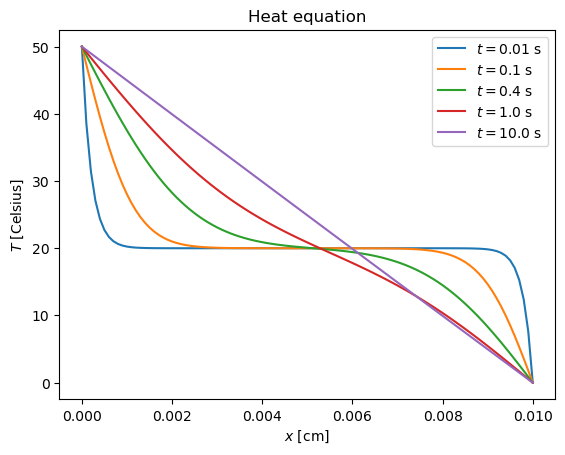
CPU times: user 554 ms, sys: 3.67 ms, total: 558 ms
Wall time: 186 ms
Animate

Crank-Nicolson scheme#
Crank-Nicolson method is a combination of FTCS and implicit schemes. Essentially it corresponds to approximating the time derivative as average of explicit and implicit methods
Applying central differences to the spatial derivatives we obtain
This corresponds to the following tri-diagonal system of linear equations
import numpy as np
def heat_crank_nicolson_iteration(u, r):
N = len(u) - 1
unew = np.empty_like(u)
# Boundary conditions
unew[0] = u[0]
unew[N] = u[N]
d = np.full(N-1, 2*(1+r))
ud = np.full(N-1, -r)
ld = np.full(N-1, -r)
# Crank-Nicolson explicit step
v = u[1:N]*2*(1-r) + u[:-2]*r + u[2:]*r
v[0] += r * u[0]
v[N-2] += r * u[N]
unew[1:N] = linsolve_tridiagonal(d, ld, ud, v)
return unew
def heat_crank_nicolson_solve(u0, h, nsteps, a, D = 1.):
u = u0.copy()
r = h * D / (a**2)
for i in range(nsteps):
u = heat_crank_nicolson_iteration(u, r)
return u
Implementation#
%%time
# Constants
L = 0.01 # Thickness of steel in meters
D = 4.25e-6 # Thermal diffusivity
N = 100 # Number of divisions in grid
a = L/N # Grid spacing
h = 1e-2 # Time-step (in s)
print("Solving the heat equation with Crank-Nicolson scheme")
print("r = h*D/a^2 =",h*D/a**2)
Tlo = 0.0 # Low temperature in Celsius
Tmid = 20.0 # Intermediate temperature in Celsius
Thi = 50.0 # High temperature in Celsius
# Initialize
u = np.zeros([N+1],float)
# Initial temperature
u[1:N] = Tmid
# Boundary conditions
u[0] = Thi
u[N] = Tlo
# For the output
times = [ 0.01, 0.1, 0.4, 1.0, 10.0 ]
profiles = []
xk = [k*a for k in range(0,N+1)]
current_time = 0.
for time in times:
nsteps = round((time - current_time)/h)
u = heat_crank_nicolson_solve(u, h, nsteps, a, D)
profiles.append(u.copy())
current_time = time
plt.title("Heat equation")
plt.xlabel('${x}$ [cm]')
plt.ylabel('${T}$ [Celsius]')
for i in range(len(times)):
plt.plot(xk,profiles[i],label="${t=}$" + str(times[i]) + " s")
plt.legend()
plt.show()
Solving the heat equation with Crank-Nicolson scheme
r = h*D/a^2 = 4.25
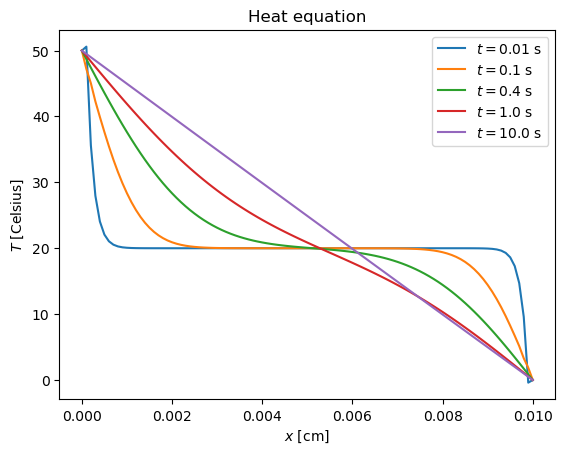
CPU times: user 555 ms, sys: 3.3 ms, total: 558 ms
Wall time: 186 ms
Heat equation in two dimensions#
In two dimensions the heat equation reads
This equation describes the time evolution of \(u(t,x,y)\) given initial profile
and boundary conditions
Now we have to perform discretization in both \(x\) and \(y\) directions. Taking the same step size \(a\) in both directions, we obtain the following discretized FTCS scheme:
Here, as before,
\(N = L_x/a\), \(M = L_y/a\), and
Implicit and Crank-Nicholson methods are also possible, but they are a bit more involved than in 1D case. Due to the presence of more than one dimension, the linear system to be solved at each time step is larger and does not have a simple tridiagonal form. However, sparse matrix methods can be used to solve this system efficiently.
Heat equation in two dimensions: FTCS implementation#
import numpy as np
# Single iteration of the 2D FTCS scheme in the time direction
# r = Dh/a^2 is the dimensionless parameter
def heat_FTCS_iteration_2D(u, r):
N, M = u.shape
unew = np.empty_like(u)
# Boundary conditions
unew[ 0, :] = u[ 0, :]
unew[N-1, :] = u[N-1, :]
unew[ :, 0] = u[ :, 0]
unew[ :, M-1] = u[ :, M-1]
# FTCS scheme
for i in range(1, M-1):
for j in range(1, N-1):
unew[i, j] = u[i, j] + r * (u[i+1, j] - 2 * u[i, j] + u[i-1, j]) + r * (u[i, j+1] - 2 * u[i, j] + u[i, j-1])
return unew
# Perform nsteps 2D FTCS time iterations for the heat equation
# u0: the initial profile
# h: the size of the time step
# nsteps: number of time steps
# a: the spatial cell size
# D: the diffusion constant
def heat_FTCS_solve_2D(u0, h, nsteps, a, D = 1.):
u = u0.copy()
r = h * D / a**2
for i in range(nsteps):
u = heat_FTCS_iteration_2D(u, r)
return u
%%time
# Constants
L = 0.01 # Thickness of steel in meters
D = 4.25e-6 # Thermal diffusivity
N = 50 # Number of divisions in grid
M = N
a = L/N # Grid spacing
h = 1e-3 # Time-step (in s)
print("Solving the 2D heat equation with FTCS scheme")
print("r = h*D/a^2 =",h*D/a**2)
Tlo = 0.0 # Low temperature in Celsius
Tmid = 20.0 # Intermediate temperature in Celsius
Thi = 50.0 # High temperature in Celsius
# Initialize
u = np.zeros([N+1,N+1],float)
# Initial temperature
u[:,:] = Tmid
# Boundary conditions
u[0,:] = Tlo
u[N,:] = Tlo
u[:,0] = Tlo
u[:,M] = Thi
# For the output
times = [ 0.01, 0.1, 0.4, 1.0]
profiles = []
xk = [k*a for k in range(0,N+1)]
yk = [k*a for k in range(0,M+1)]
current_time = 0.
for time in times:
nsteps = round((time - current_time)/h)
u = heat_FTCS_solve_2D(u, h, nsteps, a, D)
profiles.append(u.copy())
current_time = time
# Plot the initial and final temperature profiles
fig, ax = plt.subplots(1, len(times), figsize=(12, 5))
for i in range(len(ax)):
ax[i].imshow(profiles[i].T, vmax=Thi, vmin=Tlo, origin="lower", extent=[0,L,0,L])
ax[i].set_title("t = " + str(times[i]) + " s")
plt.show()
Solving the 2D heat equation with FTCS scheme
r = h*D/a^2 = 0.10625

CPU times: user 2.67 s, sys: 7.48 ms, total: 2.68 s
Wall time: 2.08 s
